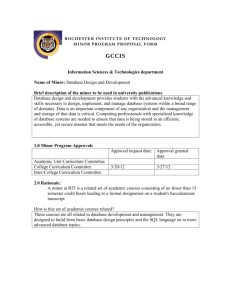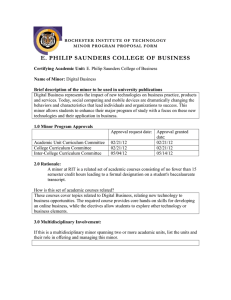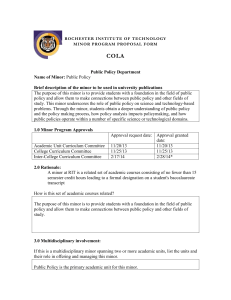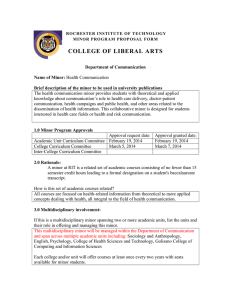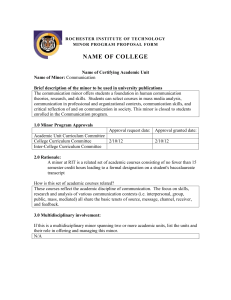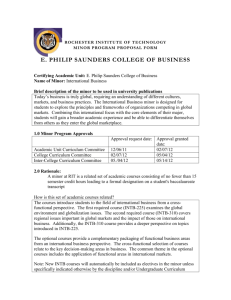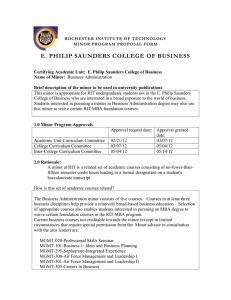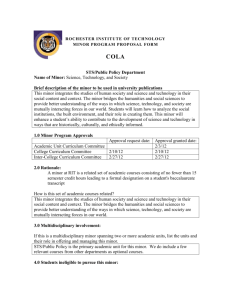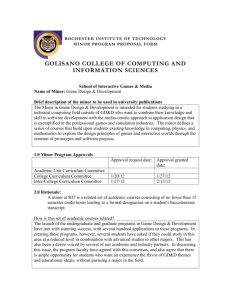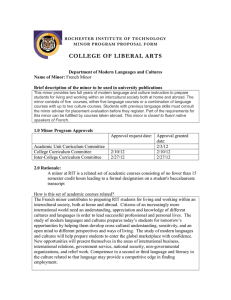Web Design and Development - Rochester Institute of Technology
advertisement
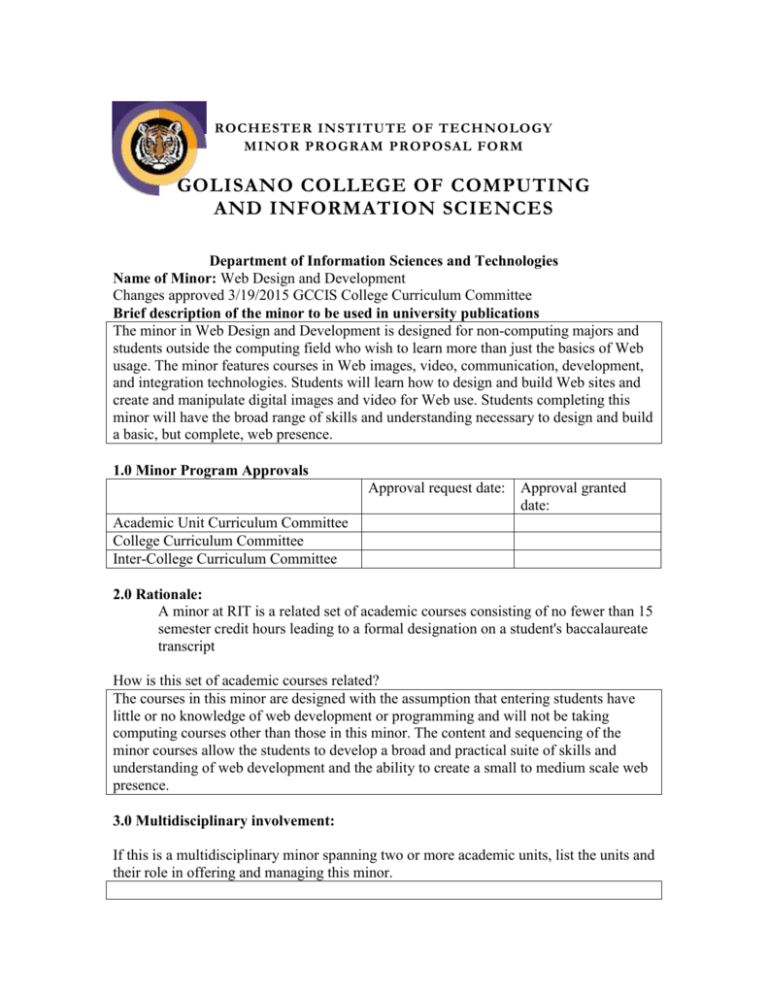
ROCHESTER INSTITUTE OF TECHNOLOGY MINOR PROGRAM PROPOSAL FORM GOLISANO COLLEGE OF COMPUTING AND INFORMATION SCIENCES Department of Information Sciences and Technologies Name of Minor: Web Design and Development Changes approved 3/19/2015 GCCIS College Curriculum Committee Brief description of the minor to be used in university publications The minor in Web Design and Development is designed for non-computing majors and students outside the computing field who wish to learn more than just the basics of Web usage. The minor features courses in Web images, video, communication, development, and integration technologies. Students will learn how to design and build Web sites and create and manipulate digital images and video for Web use. Students completing this minor will have the broad range of skills and understanding necessary to design and build a basic, but complete, web presence. 1.0 Minor Program Approvals Approval request date: Approval granted date: Academic Unit Curriculum Committee College Curriculum Committee Inter-College Curriculum Committee 2.0 Rationale: A minor at RIT is a related set of academic courses consisting of no fewer than 15 semester credit hours leading to a formal designation on a student's baccalaureate transcript How is this set of academic courses related? The courses in this minor are designed with the assumption that entering students have little or no knowledge of web development or programming and will not be taking computing courses other than those in this minor. The content and sequencing of the minor courses allow the students to develop a broad and practical suite of skills and understanding of web development and the ability to create a small to medium scale web presence. 3.0 Multidisciplinary involvement: If this is a multidisciplinary minor spanning two or more academic units, list the units and their role in offering and managing this minor. 4.0 Students ineligible to pursue this minor: The purpose of the minor is both to broaden a student's college education and deepen it in an area outside the student’s major program. A minor may be related to and complement a student’s major, or it may be in a completely different academic/professional area. It is the responsibility of the academic unit proposing a minor and the unit’s curriculum committee to indicate any home programs for which the minor is not a broadening experience. Please list below any home programs whose students will not be allowed to pursue this minor, provide the reasoning, and indicate if this exclusion has been discussed with the affected programs: This minor is not available to students whose home programs are in GCCIS. This has been discussed with GCCIS and there is another web development minor available for GCCIS students which is tailored to their needs and background. This minor and the courses and their sequence are designed to teach its students the programming and other computing skills needed since they will not be learning such skills as part of their major. 5.0 Minor Program Structure, Sequence and Course Offering Schedule: Describe the structure of the proposed minor and list all courses, their anticipated offering schedule, and any prerequisites. All minors must contain at least fifteen semester credit hours; Minors may be discipline-based or interdisciplinary; In most cases, minors shall consist of a minimum of two upper division courses (300 or above) to provide reasonable breadth and depth within the minor; As per New York State requirements, courses within the minor must be offered with sufficient frequency to allow students to complete the minor within the same time frame allowed for the completion of the baccalaureate degree; Provide a program mask showing how students will complete the minor. Narrative of Minor Program Structure: This minor is designed with a required first course (GCCIS-ISTE-105 Web Foundations OR GCCIS-ISTE-140 Web & Mobile I) three “middle courses” which can be taken in any order (GCCIS-ISTE-205 Digital Image Creation, GCCIS-ISTE-206 Digital Video Creation , and GCCIS-ISTE-305 Rapid Online Presence) and a final course which serves to bring together and build upon the learning from the preceding four courses in an integrative manner (GCCIS-IST-405 Web Integration & Application). Course Number SCH Required Optional Fall Spring Annual/ & Title Biennial GCCIS-ISTE3 X X X Annual 105 Web Foundations GCCIS-ISTE3 X X X Annual 140 Web & Mobile I Students will take either GCCIS-ISTE-105 OR GCCIS-ISTE-140 Prerequisites none none 2 GCCIS-ISTE205 Digital Image Creation 3 X GCCIS-ISTE206 Digital Video Creation 3 X GCCIS-ISTE305 Rapid Online Presence GCCIS-IST-405 Web Integration & Application 3 X 3 X Total credit hours: X X Annual X Annual X Annual X Annual GCCISISTE-105 or GCCISISTE-140 GCCISISTE-105 or GCCISISTE-140 GCCISISTE-105 GCCISISTE-105 GCCISISTE-205 GCCISISTE-305 GCCISISTE-206 15 3 Minor Course Conversion Table: Quarter Calendar and Semester Calendar Comparison Directions: The tables on this page will be used by the registrar’s office to aid student’s transitioning from the quarter calendar to the semester calendar. If this minor existed in the quarter calendar and is being converted to the semester calendar please complete the following tables. If this is a new minor that did not exist under the quarter calendar do not complete the following tables. Use the following tables to show minor course comparison in quarter and semester calendar formats. Use courses in the (2011-12) minor mask for this table. Display all required and elective minor courses. If necessary clarify how course sequences in the quarter calendar convert to semesters by either bracketing or using some other notation. Name of Minor in Semester Calendar: Name of Minor in Quarter Calendar: Name of Certifying Academic Unit: Web Design and Development Web Design and Development Department of Information Sciences and Technologies QUARTER: Current Minor Courses Course Course QCH # Title SEMESTER: Converted Minor Courses Course Course SCH # Title 4002206 Web Foundations 4 4002306 Digital Image Creation Digital Video for the Web Rapid Online Presence NetworkBased Multimedia 4 GCCISISTE105 GCCISISTE205 GCCISISTE206 GCCISISTE305 GCCISIST-405 4080310 4002406 4002535 4 4 4 Web Foundations 3 Digital Image Creation Digital Video Creation Rapid Online Presence 3 Web Integration & Application 3 Comments Must be first course in minor sequence 3 3 Must be last course in minor sequence 4 Policy Name: D1.1 MINORS POLICY 1. Definition A minor at RIT is a related set of academic courses consisting of no fewer than 15 semester credit hours leading to a formal designation on a student's baccalaureate transcript. The purpose of the minor is both to broaden a student's college education and deepen it in an area outside the student’s major program. A minor may be related to and complement a student’s major, or it may be in a completely different academic/professional area. It is the responsibility of the academic unit proposing a minor and the unit’s curriculum committee to indicate any home programs for which the minor is not a broadening experience. In most cases, minors shall consist of a minimum of two upper division courses to provide reasonable breadth and depth within the minor. 2. Institutional parameters a) Minors may be discipline-based or interdisciplinary; b) Only matriculated students may enroll in a minor; c) At least nine semester credit hours of the minor must consist of courses not required by the student's home program; d) Students may pursue multiple minors. A minimum of nine semester credit hours must be designated towards each minor; these courses may not be counted towards other minors; e) The residency requirement for a minor is a minimum of nine semester credit hours consisting of RIT courses (excluding "X" graded courses); f) Posting of the minor on the student's academic transcript requires a minimum GPA of 2.0 in each of the minor courses; g) Minors may not be added to the student's academic record after the granting of the bachelor's degree. 5 3. Development/approval/administration processes a. Minors may be developed by faculty at the departmental, inter-departmental, college, or inter-college level. As part of the minor development process: i. students ineligible for the proposed minor will be identified; ii. prerequisites, if any, will be identified; b. Minor proposals must be approved by the appropriate academic unit(s) curriculum committee, and college curriculum committee(s), before being sent to the Inter-College Curriculum Committee (ICC) for final consideration and approval. c. The academic unit offering the minor (in the case of interdisciplinary minors, the designated college/department) is responsible for the following: i. enrolling students in the minor (as space permits); ii. monitoring students progress toward completion of the minor; iii. authorizing the recording of the minor's completion on student's academic records; iv. granting of transfer credit, credit by exam, credit by experience, course substitutions, and advanced placement; v. responding to student requests for removal from the minor. d. As per New York State requirements, courses within the minor must be offered with sufficient frequency to allow students to complete the minor within the same time frame allowed for the completion of the baccalaureate degree. 4. Procedures for Minor revision It is the duty of the college curriculum committee(s) involved with a minor to maintain the program’s structure and coherence. Once a minor is approved by the ICC, changes to the minor that do not have a significant effect on its focus may be completed with the approval of the involved academic unit(s) and the college curriculum committee(s). Significant changes in the focus of the minor must be approved by the appropriate academic unit(s) curriculum committee(s), the college curriculum committee(s) and be resubmitted to the ICC for final consideration and approval. 6
